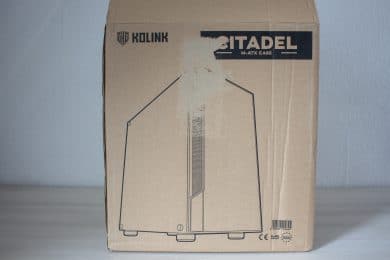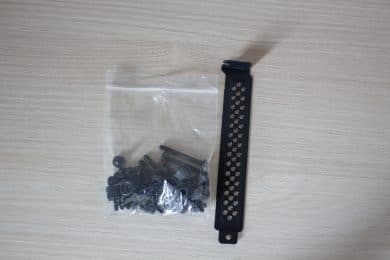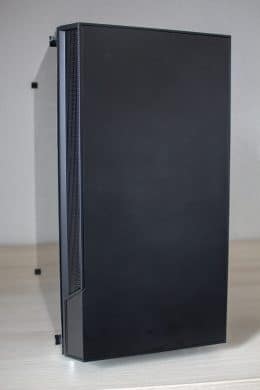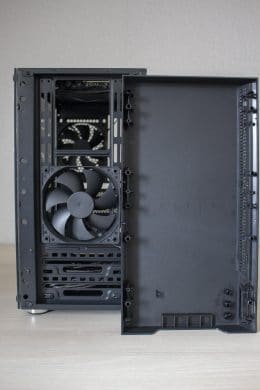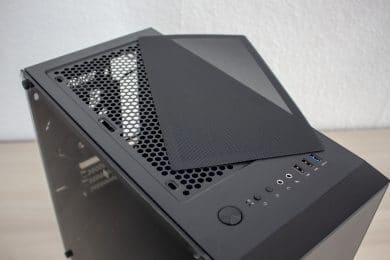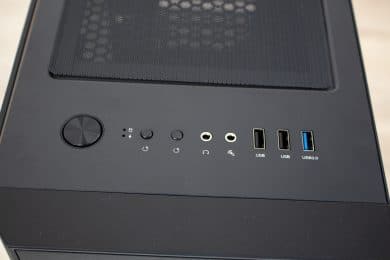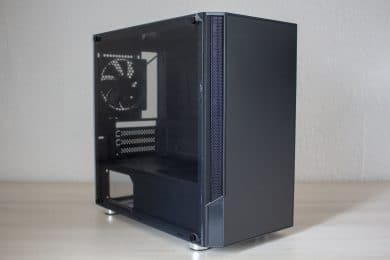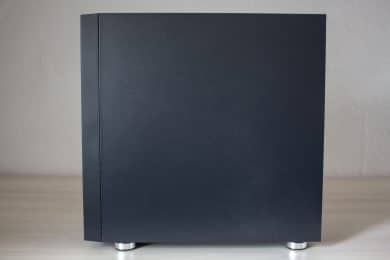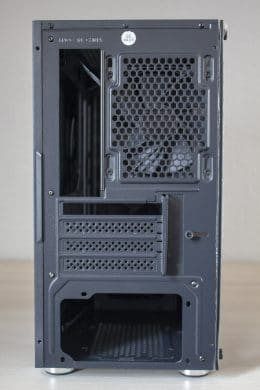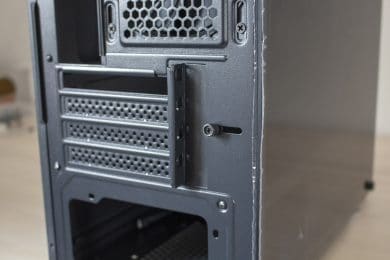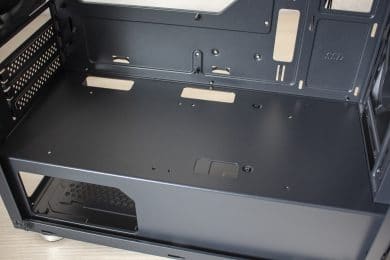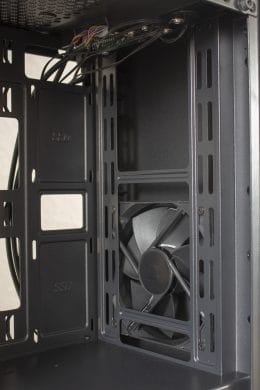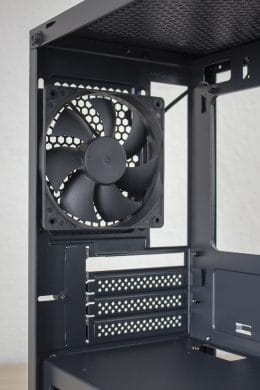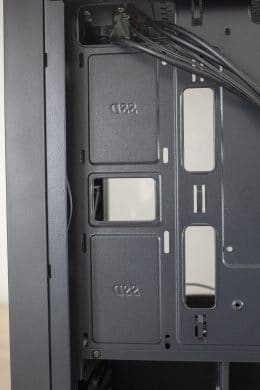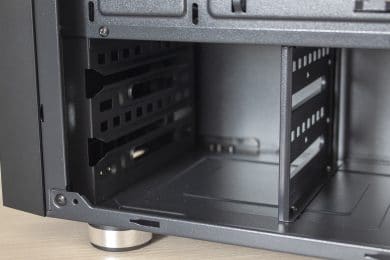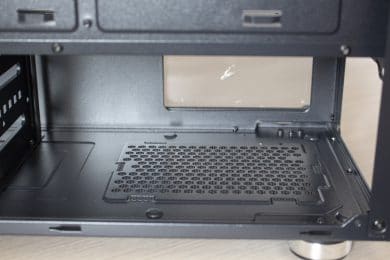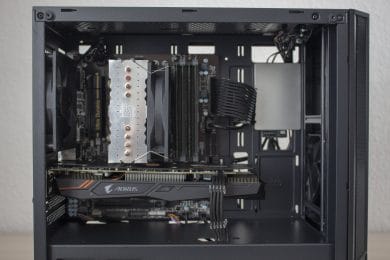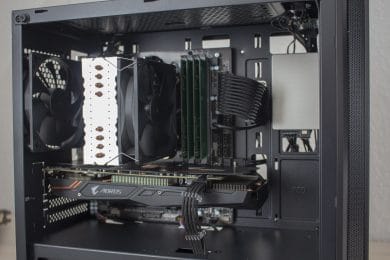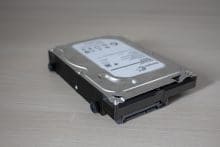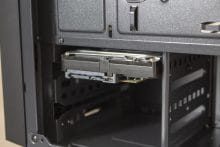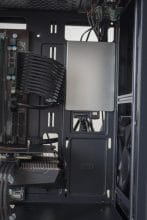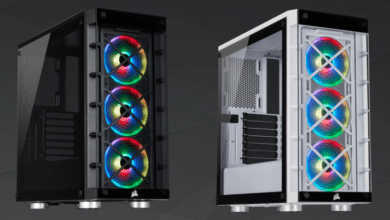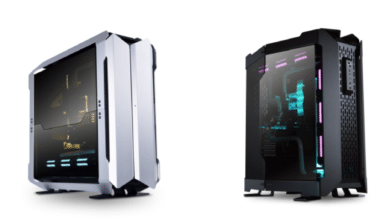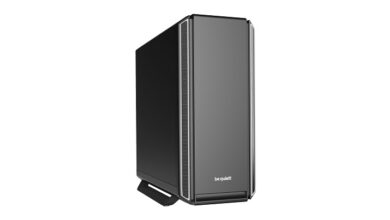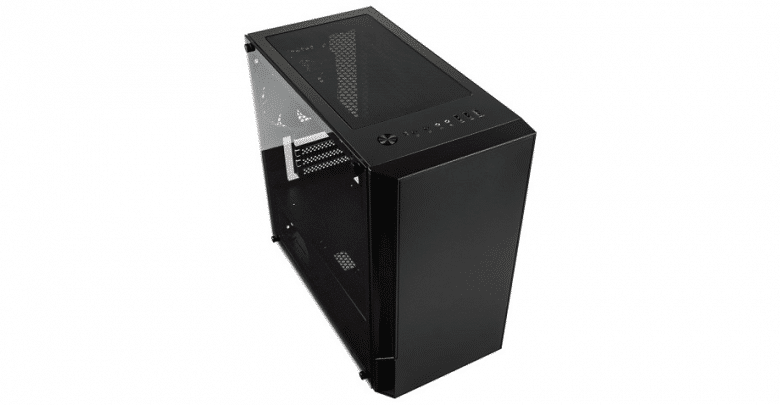
At the end of April, the manufacturer Kolink expanded its product portfolio in the area of enclosures without much notice. The new product is called Citadel and is a simple mini tower with tempered glass. As further features Kolink mentions the support of two 240 mm radiators, two pre-installed case fans and plenty of space for “powerful” hardware. The Citadel is only offered in a black version and costs € 57.89 *.
Whether this price is justified for the Kolink Citadel and how it performs in general, we will find out in this review for you.
Technical Details
| Model: | Kolink Citadel |
| Housing type: | Mini-Tower |
| Dimensions: | 202 x 410 x 395 mm (W x H x D) |
| Weight: | approx. 4.6 kg |
| Material: | Steel, plastic, tempered glass |
| Color: | Black |
| Front connections | 1x USB 3.0 Type-A, 2x USB 2.0 Type-A, 1x speaker, 1x microphone |
| Drive bays: | 2x 3,5″ (HDD cage, internal) 2x 2,5″ (internal) |
| Extension slots: | 4 |
| Form factors: | mATX, mini-ITX |
| Ventilation: | Front: 3x 120 mm or 2x 140 mm Rear: 1x 120 mm Cover: 2x 120 mm |
| Radiators: | Front: 1x 240 mm or 1x 120 mm Rear: 1x 120 mm cover: 1x 240 mm or 1x 120 mm |
| Max. CPU cooler height: | 162 mm |
| Max. Graphics card length: | 350 mm |
| Max. Power supply length: | 200 mm |
| Cable management space: | 20 mm |
| Place for front radiator: | unlimited (restricts GPU length) |
| Price: | € 57.89 * |
| Special features: | Dust filter, cable management, glass side panel |
Scope of Delivery
The Kolink Citadel comes well and safely packed in a brown cardboard box with black writing and is wrapped in polystyrene. In addition, the manufacturer has also covered the glass element with two additional protective films to protect it from scratches. The supplied accessories were fastened in a transparent plastic bag inside the housing with a cable tie. This bag only contains all important screws. Cable ties or instructions are not supplied.
The scope of delivery also includes the two pre-installed case fans and the pre-installed spacers.
Exterior Impression
Externally, Kolink is relying more on a restrained design for the Citadel. The front element is completely made of plastic and can be pulled off with a strong pull to the front. So that the pre-installed front fan can transport fresh air into the interior, there is a mesh strip on the left side of the front panel, which also serves as a dust filter. On the right side unfortunately no further fan grille was attached. We’ll see later whether this will pay off in the company.
If one raises the view, then the large fan opening in the lid catches one’s eye directly. In addition to mounting rails for radiators and fans, it also has a magnetic dust filter made of mesh. The I/O panel is also located in the cover. Available here are three USB ports (1x USB 3.0, 2x USB 2.0), 1x headphones and 1x microphone, 1x power and 2x reset. The cables for the reset button are soldered together inside the housing.
The left side part consists of 4 mm thick tempered glass and is tinted. Four flat knurled screws are used for fastening. The right side panel is made of steel and is attached to the body with two normal knurled screws.
If you place the case on its “back”, you can easily inspect the underside. But there is not much to see here. As with all other housings, Kolink uses a simple mesh grid for the dust filter for the power supply, which is held in place by metal straps. To ensure that the power supply also gets enough air, the manufacturer has equipped the underside with four silver plastic feet. These look chic and stable.

The back corresponds to the usual standard of current mini towers. The power supply unit is mounted at the bottom, above it there are four slots for PCI expansion cards. These are unfortunately to break out and Kolink only adds a badly painted metal replacement panel. Finally, the second pre-installed case fan can be found on the back.
The external processing is basically in order. There are no sharp edges and, with the exception of the PCI slot diaphragm, no paint defects. Even without side panels, the body is very stable and torsion-resistant.
Internal Impression
Like the exterior of the Kolink Citadel, the interior of this mini tower is very conservatively designed. The manufacturer also remains true to the two-chamber system at Citadel and is thus following a trend that has existed for some time.
The chambers are separated by a cover that runs through the entire lower area of the tower. Above the cover there is space for the mainboard and the expansion cards. In addition, the tray and power supply cover were equipped with openings for CPU cooler mounting and cable management. Two 2.5″ SSDs can also be displayed to the right of the mainboard. The Citadel allows a total of three 120 mm fans or two 140 mm fans to be installed in the front so that sufficient cool air can be transported into the interior.
Let us now turn to the back and the lower chamber. The power supply unit and two further hard disks are accommodated in this. Kolink uses a riveted hard disk cage to accommodate two 3.5″ HDDs. Since the hard disks touch the hard disk cage directly with one side, there will be no decoupling. With certain frames that are not included in the scope of delivery, two 2.5″ data carriers can also be accommodated here. The power supply unit is located to the right of the HDD cage and rests uncoupled on normal steel stand-offs.
The interior processing is fine for the desired price class. The paintwork has no noticeable flaws and there are no sharp edges to cut yourself on. Only the material thickness could be somewhat higher in places.
System Construction in Kolink Citadel
Now we come to system installation. As hardware we use a Intel Xeon 1230v3 on a Gigabyte H87M-D3H with 16GB RAM. The Xeon is represented by a LC-Power Cosmo Cool LC-CC-120 cooled. A GTX 1060 6GB from Gigabte AORUS* is responsible for the image output. The power supply does the non-modular be quiet! Pure Power with 400W. In order to enhance the cabling optically a little bit, single sleeved cable extensions from Phanteks.
The installation and wiring of the test system was quickly completed due to the good space conditions and the pre-installed spacers. Also with the selection of components one must make oneself as a buyer almost no thoughts. The Citadel supports CPU coolers up to 162 mm in height and graphics cards up to 350 mm in length. In addition, one could also place a 240 mm radiator in the lid or the front if required. However, a radiator in the front limits the length of the graphics card accordingly.
On the back side there is approx. 20 mm space to store numerous cables. In combination with the power supply cover and the well-placed cable management openings, this leads to a neat end result, at least on the front side. However, you should not use cable extensions in this housing. The side part can still be closed, but all areas under the cover are stuffed with cables.

A small point of criticism of the Kolink Citadel is the assembly of the data carriers. For mounting, two special screws with rubber decouplers are attached to the left side of the data carrier. The hard disk is then pushed into the cage and a knurled screw on the right side prevents it from falling out. Despite the decouplers, the HDD on the right touches the steel directly. This leads to an unpleasant transmission of vibrations. Since SSDs are too small for the cage, they can only be attached to the mainboard tray. Suitable cable management openings are available for this purpose.
The pre-installed fans have a frame width of 120 mm, rotate at a maximum of 1200 rpm and are connected to the mainboard via a 3-pin connector. At full speed, air is moved noticeably, but the fans are also audible. There is no vacuum cleaner under the table, but silent fans have to replace the fans because of the bearing noises.
Finally, we come to the temperatures that were reached in the Citadel. During the load test, Prime95 and FurMark were carried out for 15 minutes at a room temperature of 17 °C. The test was carried out at a temperature of 17 °C. In addition, this test was carried out in two different variants (with front panel and without front panel).
Scenario |
Temperature |
| with front panel CPU: 50%. Housing: 100% |
CPU: 64 GPU: 66 |
| without front panel CPU: 50%. Housing: 100% |
CPU: 57 GPU: 59 |
Without the front panel, the temperatures for both components drop by 7°C. This strongly suggests that the fan is limited by the one-sided mesh element and cannot fully exploit its potential. A further mesh element on the right side of the front panel would have probably led to better results.
Conclusion of the Kolink Citadel Review
Let us now come to a final conclusion for the Kolink Citadel. This mini tower offers an elegant and unagitated design with plenty of room for hardware and even radiators. In addition, the pre-installed fans and the glass side panel speak for the Citadel.
In order to keep the price of € 57.89 *, the manufacturer also had to apply the red pencil in some places. Therefore, only one USB 3.0 port was installed in the I/O panel and the PCI slot bezels are not reusable. The main points of criticism, however, are the airflow reduced front panel and the way 3.5″ hard disks have to be mounted. Anyone who wants to install high-end components in the Citadel should consider this twice due to possible temperature problems.
If one can live with these weak lives, the Kolink Citadel is a good but by far not unique case considering the price. The competition’s not sleeping!
Kolink Citadel
Workmanship
Structure
Features
Cooling
Value for Money
Stylish mini tower with lots of space but weak airflow.



